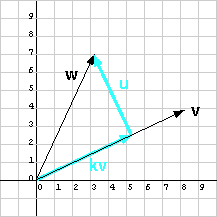Another Example
You don't have to compute the length of w.
It cancels out before the final answer.
And, all you need is the square of the length of v, |v|2.
Some books show formulae for projection that make use of these
facts (but, to my taste, are less intuitive).
The diagram shows another example, this time not so easy.
The vector w is represented by by (3.2, 7)T.
The vector v is represented by by (8, 4)T.
Find kv and u.
- Compute the lengths:
- | w | = (keep it symbolic)
- | v |2 =
((8, 4)T·(8, 4)T)
= 80
- Compute the unit vectors:
- wu = (3.2, 7)T / | w |
- vu = (8, 4)T / | v |
- Compute the cosine of the angle between the vectors:
- wu · vu
= (3.2, 7)T / | w | · (8, 4)T / | v |
= 53.6/( | w || v |)
- Assemble the projection:
- kv = | w | (wu·vu) vu
- kv = | w | [53.6 / (| w || v |)] (8, 4)T / | v |
- kv = 53.6 / (| v |) (8, 4)T / | v |
- kv = 53.6 / (| v |2) (8, 4)T
- kv = 53.6 / 80 (8, 4)T
- kv = ((53.6*8)/80, (53.6*4)/80)T
= ( 5.3, 2.68)T
- Compute the orthogonal vector:
- u = w - kv
- u = (3.2, 7)T - (5.3, 2.68)T
= (-2.1, 4.32)T
|

|

